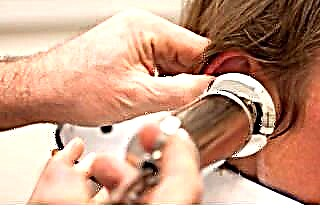The feeling of a stuffy nose is not the most pleasant, but absolutely familiar to everyone. Moreover, it so happens that it is not possible to get rid of nasal congestion, even by applying several different medicines for the common cold. And sometimes the situation gets worse. This means that the drugs are selected incorrectly and you need to start by finding out the reason for the problem.
Causes of congestion
 There are only three types of reasons why a runny nose may appear: allergic, infectious and non-infectious. It is not always possible to distinguish them on your own, but if you look closely at the accompanying symptoms, then the task does not seem impossible:
There are only three types of reasons why a runny nose may appear: allergic, infectious and non-infectious. It is not always possible to distinguish them on your own, but if you look closely at the accompanying symptoms, then the task does not seem impossible:
- Allergic - accompanied by a dry, tearful cough, redness and itching of the mucous membranes of the eyes, tearing, edema, and sometimes skin manifestations. Nasal congestion is precisely due to severe swelling of the mucous membranes, which almost completely block the nasal passages. Only taking antihistamines can make breathing easier.
- Infectious - they are usually indicated by thick yellow or green snot, which accumulate in the nose, flow down the back wall of the mucous membrane and provoke a gurgling cough. May be accompanied by fever, sore throat, and other symptoms. In this case, in order to completely remove nasal congestion, complex treatment with the use of several drugs will be required.
- Non-infectious - in this case, breathing becomes difficult due to the blockage of the nasal passages due to the ingress of foreign objects into them or after injury. Less commonly, the cause is congenital or acquired in any way curvature of the nasal septum. The only way to relieve nasal congestion in this case is to completely eliminate the cause. The use of any medication will not work.
And now let's consider what an effective treatment for a common cold can be in each case.
Allergy treatment
If nasal congestion occurs as a symptom of an allergic reaction, then first of all it is necessary to remove it with the help of antihistamines. The fastest way to do this is the following medications:
- Suprastin;
- Claritin;
- Diazolin;
- Loratadin;
- "Cetarizin".
But this is not a solution to the problem at all. As soon as the action of the drug stops, the allergic rhinitis will return again, and with it - the nasal congestion.
 Therefore, the second necessary step is to accurately determine the allergen, which can be: household chemicals, a pet, pollen, tobacco smoke, even ordinary dust. Unsuitable perfume, too strong odors, etc. can irritate the nasal mucosa and cause it to swell.
Therefore, the second necessary step is to accurately determine the allergen, which can be: household chemicals, a pet, pollen, tobacco smoke, even ordinary dust. Unsuitable perfume, too strong odors, etc. can irritate the nasal mucosa and cause it to swell.
If the effect of the allergen cannot be completely eliminated, then the intake of antihistamines will have to be made regular. In this case, it is imperative to consult a doctor, since most of these drugs are not intended for long-term use and can cause a number of unwanted side effects.
Treatment for infection
 With an infectious cause of a runny nose, congestion occurs due to a large amount of snot accumulated in the nasal passages. To clear your nose in such a situation, first of all, you need to blow your nose, and then thoroughly rinse with a solution of sea salt, a decoction of chamomile, calendula or furacilin. You can also use ready-made pharmaceutical preparations for rinsing the nose such as "Aquamaris".
With an infectious cause of a runny nose, congestion occurs due to a large amount of snot accumulated in the nasal passages. To clear your nose in such a situation, first of all, you need to blow your nose, and then thoroughly rinse with a solution of sea salt, a decoction of chamomile, calendula or furacilin. You can also use ready-made pharmaceutical preparations for rinsing the nose such as "Aquamaris".
Further treatment depends on what kind of pathogenic microorganisms caused the runny nose. To do this, it is better to still go to the doctor and get tested for microflora. It will allow you to accurately identify the pathogen and select the most effective medicine. Complex treatment, which will help to quickly get rid of even severe nasal congestion, is a combination of drugs, which may include:
- antibacterial - to quickly destroy pathogenic bacteria;
- anti-inflammatory - to soothe irritated mucous membranes and reduce the amount of discharge;
- antihistamines - to quickly relieve swelling of the mucous membranes, if any, and thus pierce the nose;
- immunomodulators - to strengthen the immune system and speed up the healing process;
- antipyretic - only if the body temperature is above 38.5C.
If possible, physiotherapeutic procedures are connected: UHF, electrophoresis, heating with solux, quartzing, heating with a laser. They enhance the effects of drugs, stimulate the body's defenses and help relieve nasal congestion.
Treatment during pregnancy
 Difficulty breathing during pregnancy can be caused by hormonal causes. A change in the hormonal background (often abrupt) provokes the so-called vasomotor rhinitis, which eventually goes away on its own without any treatment. In this case, the usual Zvezda balm or its analogs with mint or eucalyptus oils will help to pierce the nose.
Difficulty breathing during pregnancy can be caused by hormonal causes. A change in the hormonal background (often abrupt) provokes the so-called vasomotor rhinitis, which eventually goes away on its own without any treatment. In this case, the usual Zvezda balm or its analogs with mint or eucalyptus oils will help to pierce the nose.
But if a severe runny nose in a pregnant woman is caused by an infection that has entered the body, then it is better to wait with the use of traditional medicines, and try to remove snot and ease breathing with the help of safe and simple folk remedies:
- Garlic or onion juice with honey. Crush or finely grate garlic or onions, wrap in several layers of gauze and squeeze out the juice. Dilute the juice in half with honey and instill 3-5 drops 3-4 times a day.
- Nasal drops with essential oils. It is easy to prepare at home by mixing the selected essential oil (eucalyptus, mint, sage, calendula, celandine, coltsfoot) with sea buckthorn (olive, sunflower) in a proportion of 3-5 drops of essential oil per 1 teaspoon of the base oil. You can bury it up to 5-6 times a day.
 Kalanchoe juice - pure or with honey, helps to quickly clear the nose due to the fact that it slightly irritates its mucous membranes, causing a sneezing reflex. It also has strong antibacterial properties, relieves inflammation and swelling. Enough 3-5 drops 2-3 times a day.
Kalanchoe juice - pure or with honey, helps to quickly clear the nose due to the fact that it slightly irritates its mucous membranes, causing a sneezing reflex. It also has strong antibacterial properties, relieves inflammation and swelling. Enough 3-5 drops 2-3 times a day.- Tea tree oil is great for inhalation. But even if you do not tolerate inhalation well, you can pour it into an aroma lamp and just sit next to it. It is able to quickly clear the room and the upper respiratory tract from pathogenic bacteria.
- Chamomile flower compress. It helps to warm up the sinuses well, remove inflammation and swelling of the mucous membranes. A tablespoon of flowers must be poured with a glass of boiling water, boiled for 3-5 minutes and allowed to cool to a comfortable temperature. Drain the water, wrap the flowers in several layers of gauze or cotton cloth and attach on both sides of the bridge of the nose. Do it 3-4 times a day, do not go outside.
- Salt bath for hands. Dip your hands in warm saline solution and hold until the water cools. You can't hover your feet! And you can add a little more olive oil and pine or fir essential oil to the hand bath. So the skin of the hands will improve and the nose will quickly be cleared.
 Inhalation over mashed potatoes. Before doing it, you need to make sure that there are no nitrates in the potatoes, which, if inhaled, can provoke allergies and only worsen the situation. Peel the potatoes, cook until tender, crush in mashed potatoes, sit over a saucepan, cover your head with a towel and breathe for up to 10-15 minutes. Do not eat mashed potatoes!
Inhalation over mashed potatoes. Before doing it, you need to make sure that there are no nitrates in the potatoes, which, if inhaled, can provoke allergies and only worsen the situation. Peel the potatoes, cook until tender, crush in mashed potatoes, sit over a saucepan, cover your head with a towel and breathe for up to 10-15 minutes. Do not eat mashed potatoes!
There are other effective alternative ways to get rid of nasal congestion that can be used during pregnancy. But here it is very important not to miss the moment when the disease begins to intensify. Therefore, if it was not possible to eliminate severe congestion at home in 2-3 days, you need to seek medical help.
Congestion in infants
 In infants, the nose may be obstructed only because the baby is not being cared for properly. His nasal passages are so narrow that they are not yet able to cleanse themselves, so mom must do this daily. Rinsing the nose for preventive purposes is enough 1-2 times a week. And if the baby is still sick, then this should be done several times a day before burying his nose.
In infants, the nose may be obstructed only because the baby is not being cared for properly. His nasal passages are so narrow that they are not yet able to cleanse themselves, so mom must do this daily. Rinsing the nose for preventive purposes is enough 1-2 times a week. And if the baby is still sick, then this should be done several times a day before burying his nose.
Most of the folk remedies approved for pregnant women are suitable for the smallest. The only exception is nasal drops with garlic juice - they can burn the delicate mucous membrane of the child. But garlic can be used in a different way: wrap it in a cotton or linen cloth and rub the nose on both sides, after smearing it with baby cream. It is better to do this at night so that the juice does not get into your eyes.
If the child's snot is not yellow or green (not purulent), then the nasal congestion is well removed with an ordinary boiled egg. It is cooled to a temperature comfortable for the child, and then the nose is massaged in circular movements on both sides of the bridge of the nose. Then it is better to throw the egg away.
 If the baby is breastfed, you can drip the baby's nose with breast milk. It contains ready-made antibodies that easily cope with bacteria that have entered the child's body, at the same time being a powerful and completely safe immunomodulator for the baby.
If the baby is breastfed, you can drip the baby's nose with breast milk. It contains ready-made antibodies that easily cope with bacteria that have entered the child's body, at the same time being a powerful and completely safe immunomodulator for the baby.
But in any case, you need to carefully monitor the general condition of the child. With proper and effective treatment, even a severe runny nose disappears in a maximum of 3-5 days. If this does not happen, the snot has acquired a yellowish or greenish tint, the body temperature has risen, or other unpleasant symptoms have appeared - you need to immediately show the child to a doctor. Lack of treatment can lead to serious complications and chronic diseases.

 Kalanchoe juice - pure or with honey, helps to quickly clear the nose due to the fact that it slightly irritates its mucous membranes, causing a sneezing reflex. It also has strong antibacterial properties, relieves inflammation and swelling. Enough 3-5 drops 2-3 times a day.
Kalanchoe juice - pure or with honey, helps to quickly clear the nose due to the fact that it slightly irritates its mucous membranes, causing a sneezing reflex. It also has strong antibacterial properties, relieves inflammation and swelling. Enough 3-5 drops 2-3 times a day. Inhalation over mashed potatoes. Before doing it, you need to make sure that there are no nitrates in the potatoes, which, if inhaled, can provoke allergies and only worsen the situation. Peel the potatoes, cook until tender, crush in mashed potatoes, sit over a saucepan, cover your head with a towel and breathe for up to 10-15 minutes. Do not eat mashed potatoes!
Inhalation over mashed potatoes. Before doing it, you need to make sure that there are no nitrates in the potatoes, which, if inhaled, can provoke allergies and only worsen the situation. Peel the potatoes, cook until tender, crush in mashed potatoes, sit over a saucepan, cover your head with a towel and breathe for up to 10-15 minutes. Do not eat mashed potatoes!

